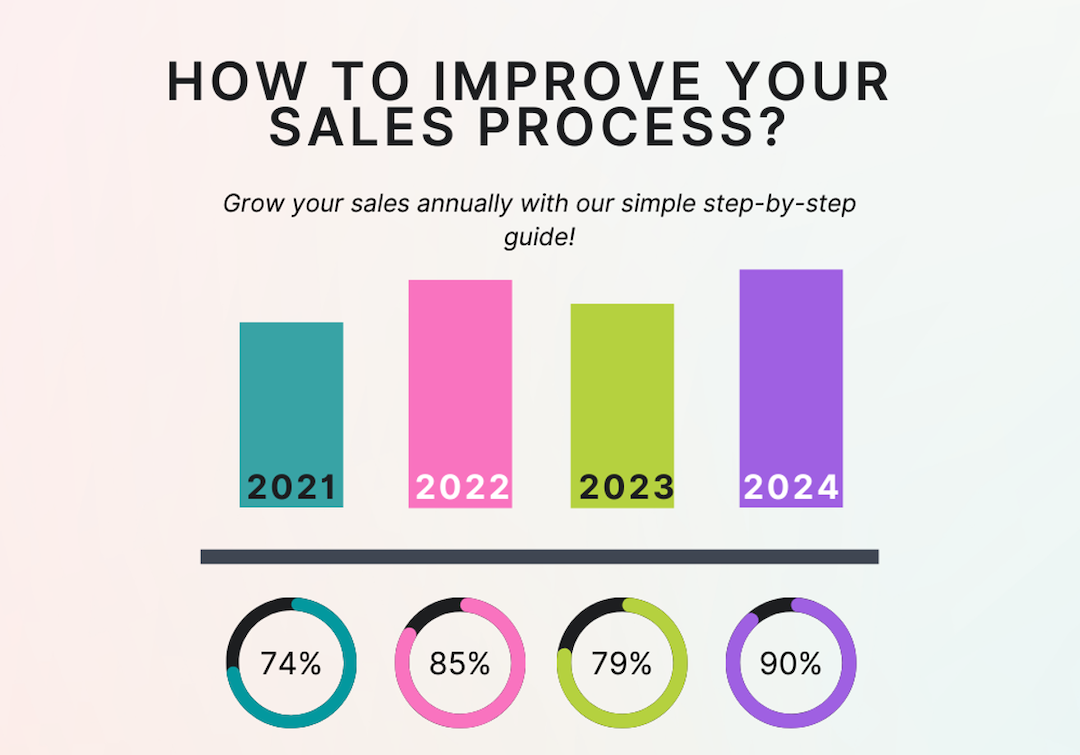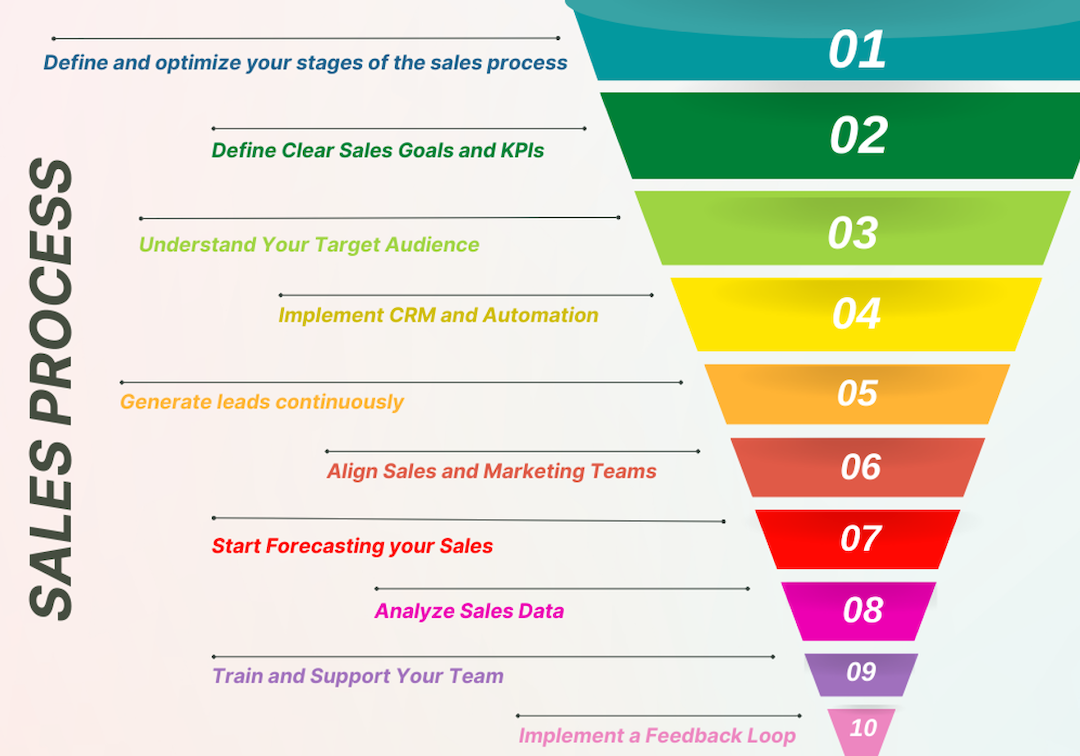
Are you ready to improve the sales process of your business and boost its effectiveness?
Success depends on your ability to refine your sales efficiency. Optimizing your approach is necessary, regardless of your level of sales experience.
Implementing strategic adjustments to your sales process can elevate your sales performance and help you embrace emerging opportunities.
Let's look at some key steps you can take to optimize the sales process and results.
What is the Sales Process?
The sales process is a systematic set of actions that sales professionals take to convert leads into customers.
The sales process stages include prospecting, qualifying, presenting, resolving objections, closing, and follow-up. Every phase aims to bring the potential customer one step closer to purchasing.
Understand and optimize the sales process of your company to improve productivity, identify areas for development, and eventually increase revenue. Monitoring sales efficiency measures makes tracking performance and making data-driven decisions to streamline the process more accessible.
Therefore, the sales process is a strategic map for sales teams to follow to accomplish their objectives and build customer relationships.
10 Key Steps to Improve Your Sales Process

Learn how to improve the sales process and produce exceptional outcomes. Understanding your customers' needs, adopting advanced technology, and providing constant training are all calculated strategic actions that increase productivity and revenue.
This guide covers key strategies to maximize sales, enabling you to build closer relationships with clients and grow your company.
1. Define and optimize your stages of the sales process
Start by outlining an organized sales process aligned with your company objectives. Determine the critical phases, such as lead generation, qualification, closing, and presentation. Make sure every phase accommodates the preferences and journey of your customers.
Take advantage of performance metrics and feedback to evaluate and improve the process continuously. This continuous method improves overall performance and maximizes efficiency. By continually evolving your sales process, you can adjust to changes in the market and improve customer satisfaction, which will result in long-term business growth.
2. Define Clear Sales Goals and KPIs
Begin by establishing clear sales goals that align with your primary business objectives. Set quantifiable, specific targets for revenue and customer acquisition.
Choose key performance indicators (KPIs) to monitor development and assess achievements, such as:
- Conversion rates
- Average deal size
- Sales velocity
Make sure that everyone on your sales team understands these objectives and KPIs. Review them frequently and make the necessary changes to remain flexible and sensitive to market changes. This proactive strategy encourages responsibility and promotes further growth in the sales team.
3. Understand Your Target Audience
Conduct thorough research to take the first step toward understanding your target market. If you want helpful information, analyze preferences, problems, and demographics. Collect relevant information by using tools such as analytics and surveys.
Focus on your customer's behavior and purchase patterns to personalize your sales process effectively. This essential knowledge improves your ability to create customized solutions that connect with your audience.
Continuously evaluate and adjust to meet evolving customer needs and market trends.
4. Implement CRM and Automation
Use automation tools and CRM (Customer Relationship Management) to optimize the sales process of your business.
CRM systems improve effective lead tracking and interaction with client management. Automation reduces manual tasks and allows your team to concentrate on essential tasks. Use these cloud-based tools to maintain leads through automated workflows and monitor communication while keeping customer data organized.
Maintaining your CRM system will help it stay current with changing business requirements and increase productivity.
5. Generate leads continuously
The next step is to start implementing lead-generation strategies. To do this, you will use various outbound and inbound marketing strategies to draw in potential consumers.
"Generating leads is essential for sustaining business growth," O'Connell says. "It's about keeping a steady flow of potential clients entering your sales pipeline. You can also use a LinkedIn CRM integration to add LinkedIn contacts to your CRM in one click, enrich contact data, and view and edit deals within LinkedIn".
Strategies for generating leads that work well include:
- Employing SEO and content development as inbound marketing strategies for bringing in leads.
- Cold outreach and email marketing are examples of outbound strategies for connecting with possible customers.
- Using social media platforms to interact with and increase your audience's attention.
You can determine which channels are effective and adjust your strategy by regularly tracking and evaluating your attempts to generate leads. This continuous procedure guarantees consistent leads to support your sales pipeline.
6. Align Sales and Marketing Teams
For effective strategy execution and consistent messaging, the sales and marketing teams must be in sync.
Cooperation guarantees standardization over every customer interaction, improving the brand's perception.
An integrated approach to customer engagement fostered by clear communication produces improved outcomes.
Organizations can increase effectiveness and efficiency by tearing down corporate walls and encouraging cross-functional teamwork. Frequent goal-setting sessions and collaboration meetings help sales and marketing teams work together more effectively, eventually boosting sales and customer satisfaction.
7. Start Forecasting your Sales
To predict future performance and make wise decisions, start forecasting your sales.
- Analyze historical sales data
- Identify patterns and trends
- Consider the dynamics of the market
- Set achievable goals
Proactive planning and resource allocation are made possible by forecasting and providing alignment with company objectives. Review and modify predictions regularly in light of feedback and new trends. This tactical method supports adaptability and sets up your company for long-term success.
8. Analyze Sales Data
Effective decision-making and performance optimization depend significantly on the analysis of sales data, facilitated by utilizing a sales report template.
Analyze sales metrics like:
- Growth in revenue
- Cost of acquiring new customers
- Conversion rates for sales
Determine patterns and trends in:
- Consumer actions
- Client interest
Make use of tools for data analytics to:
- Information display
- Comprehensive understanding
Review and adjust tactics frequently, considering the implications of data findings to promote ongoing development and increase sales performance.
9. Train and Support Your Team
Offering personal growth and optimizing sales efficiency requires investing in and supporting your team. Offer extensive training courses to give your staff the necessary know-how and abilities.
Provide continuous assistance for overcoming obstacles and fostering self-confidence. Facilitate ongoing education and training to stay current with market trends and best practices.
Investing in your team's development creates a skilled and motivated workforce that leads to success and meets sales efficiency targets.
10. Implement a Feedback Loop
Creating a mechanism for receiving feedback in your sales process is essential to continuous growth. Promote open communication lines so clients and sales representatives can share their experiences. Review the suggestions regularly to find areas for improvement and address any issues that arise. Adjust your sales tactics, messaging, and procedures to serve customers better and increase satisfaction.
Utilizing feedback in your sales process shows that you are customer-centric and make sure that your efforts align with changing market demands, ultimately leading to higher success and metrics for sales efficiency.
Remember to employ closed-loop feedback, ensuring that feedback isn't simply gathered but is utilized to enhance and maintain customer satisfaction.
Pro Tip
Integrate a price quote into your sales process to facilitate seamless transactions and solidify customer relationships. Implement Billdu invoicing software to efficiently generate and deliver accurate price quotes tailored specifically for each client.
Why is a price quote essential for your sales process?
With Billdu, you can create professional price quotes, track their status, and quickly convert them into invoices once the customer accepts them. Enhance efficiency, improve accuracy, and drive better outcomes from your sales process with Billdu!
What is Sales Efficiency and How to Measure it?
How can sales teams minimize resources while making the most impact possible? That's where sales efficiency comes in.
The key is to maximize results with the least amount of work by automating processes and making the most of available resources. In the sales world, it's the art of doing.
These measurements highlight sales performance and direct tactical choices to maximize effectiveness.
Sales Conversion Rate
- Definition: The percentage of potential clients or leads that turn in sales.
- Calculation: Take the total number of leads or divide it by the number of closed deals. Then multiply the result by 100.
- Importance: Indicates the effectiveness of converting leads into customers and the overall efficiency of the sales process.
Length of Sales Cycle
- Definition: The duration required to turn a lead into a paying client.
- Calculation: Measure the time between reaching out to a lead and closing the deal, then average the time for all deals.
- Importance: Helps locate obstacles or weaknesses in the sales procedure and directs endeavors to optimize functions.
Lead Response Time
- Definition: The time salespeople need to reply to potential clients or questions.
- Calculation: Determine how long it took to contact a prospect after receiving an inquiry.
- Importance: Speedier responses increase the likelihood of closing deals, impacting customer satisfaction and conversion rates.
Customer Acquisition Cost (CAC)
- Definition: The price paid for bringing on a new client.
- Calculation: Divide the total amount spent on marketing and sales by the quantity of new clients brought in during a given time frame.
- Importance: This position determines the success and effectiveness of marketing and sales initiatives that bring in new clients and directs the allocation of funds.
Conclusion
Ultimately, your goal is to improve the sales process, increase revenue creation, and lower expenses. Regularly analyze essential metrics to find areas for improvement.
You must constantly improve and adapt to succeed over time and reach the goals set for your business. Act now if you want to boost your sales process and increase revenue!
Share this post
Leave a comment
All comments are moderated. Spammy and bot submitted comments are deleted. Please submit the comments that are helpful to others, and we'll approve your comments. A comment that includes outbound link will only be approved if the content is relevant to the topic, and has some value to our readers.

Comments (0)
No comment